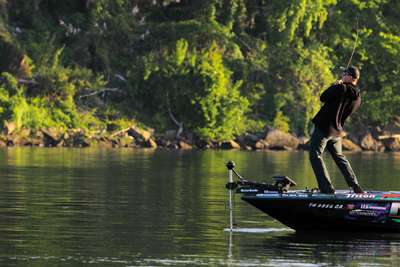
Sometimes you’ll visit new water where everything looks “bassy.” Fish there have an abundance of hideouts, including vast flats of aquatic vegetation, rocky shorelines dotted with laydowns and stands of inundated timber. When encountering multiple cover options like this, where should you start looking for bass?
“One of the first things I do is find out where most of the life is, meaning bait — or fish in general — and birds,” says Bassmaster Elite Series pro Aaron Martens. “I do look for herons a lot. Herons and some other birds will gather in areas (looking for food) this time of year, so I read that.”
The Alabama pro believes finding baitfish is also a key to discerning which type of cover to fish, especially in the summer. “Usually this time of year the fish will be where the most bait is, so look for balls of shad on the graph in an area,” says Martens.
Rather than check out the cover in an area, Martens relies on side imaging technology to search for baitfish. After scanning a cove or a flat, Martens moves to some other areas and continues searching for the spots that hold the most balls of shad.
Then he returns to the spot that contained the most baitfish balls and dissects the area. “I start to look around and see what stuff looks right and then I fish that cover,” he says. Structure also becomes a key in the summertime for finding bass on multiple cover waters. “The fish might be on the main lake points and not all the way back (in the coves),” says Martens.
So the standing timber on points will probably be more productive than those shallow weeds in the bays. In most situations, Martens discovers aquatic vegetation usually trumps any other cover on lakes with multiple bass options. “Grass is usually hard to beat,” he says. “Any time you have a lake with grass in it, the grass usually plays a huge factor.”
The shade and cooler water under grass mats attracts baitfish and bass better than other types of cover. Mixed cover such as a stump, large rock or laydown engulfed by grass tends to hold more quality fish during the summer. “Big fish seem to be homesteaders and will take over a certain spot this time of year,” says Martens. The five-time BASS winner knows if he catches a 5-pounder from such a spot, he can release the fish, mark the spot with his GPS and come back three or four days later and catch that same fish. Targeting isolated wood cover rather than stands of timber works best for Martens during the sum
mertime. “When you have lakes that have tons of timber, it can be too much sometimes, especially this time of year,” he advises. During the spring, Martens favors targeting long stretches of grass or rows of stumps because prespawn and spawning bass tend to scatter throughout the cover. “I like isolated cover in the summer because it concentrates the fish a little bit better so it makes them a little more predictable,” he says. Multiple cover lakes usually require stealth tactics and long casts to catch the most bass.
“Normally those lakes are a lot clearer and shallower so when you have that situation, presentation is extremely important,” says Martens. A variety of tactics work for Martens on multiple cover waters. “When I’m fishing a lake like that, I’ll normally have 12 rods out,” he says. His favorite tactics though are buzzing a frog (Reaction Innovations Swamp Donkey) over the grass and flipping soft plastics or jigs in the weeds or timber.
Other lures that produce for Martens in the weeds and wood are a Reactions Innovations Skinny Dipper and a Basstrix swimbait. When fishing shallow grass, Martens ties his lures on 30-pound braid. He opts for 20- to 25-pound test Sunline Shooter Fluorocarbon for pitching into timber.
Editor’s Note: If you have a story idea you would like to vote on for an upcoming poll, send your idea to john@jnoutdoors.com.





